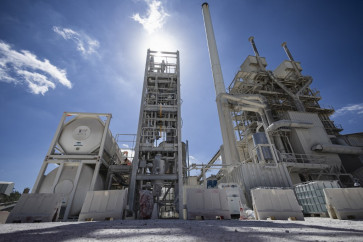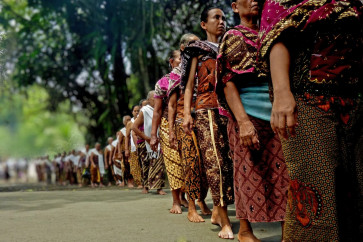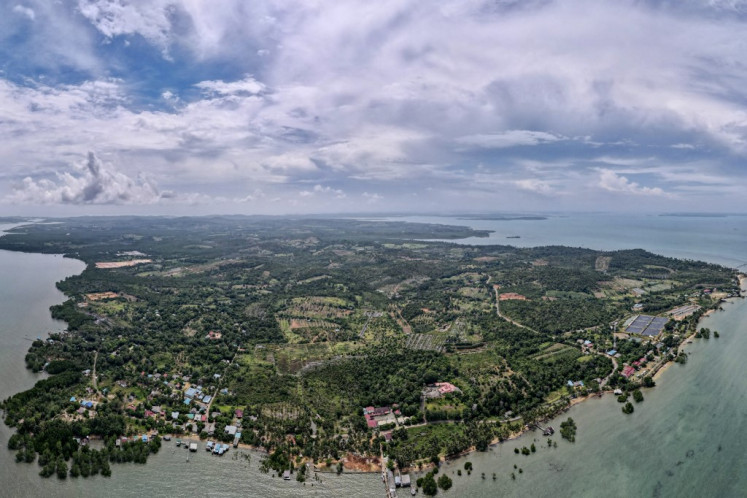Popular Reads
Top Results
Can't find what you're looking for?
View all search resultsPopular Reads
Top Results
Can't find what you're looking for?
View all search resultsGaharu: Indonesia's endangered fragrant wood
Natural products: Natural Gaharu wood, now difficult to find in forests, is cut up and kept in jars
Change text size
Gift Premium Articles
to Anyone
Natural products: Natural Gaharu wood, now difficult to find in forests, is cut up and kept in jars. JP/Theresia Sufa
Indonesia is known as one of the world's producers of gaharu, also called agarwood or just agar, the resinous heartwood from Aquilaria trees, of which 26 species can be found in Sumatra, Kalimantan, Sulawesi, Nusa Tenggara, Maluku and Papua.
The existence of these trees, however, is under threat.
Gaharu is valued in many cultures for its distinctive fragrance, and has been widely used as an incense as well as for perfumes and medicine.
Yana Sumarna, an employee at the Center for Forest Research and Development and Nature Conservation, at Bogor's Forestry Research Agency, said gaharu had drawn the interest of consumers both at home and overseas.
The resin looks like a dark brown to black solid lump or a chunk with a fragrant smell (if burned), which is found in the heartwood or roots of gaharu-producing trees undergoing a chemical and physical change due to fungus infection. But not all plants can produce the resin,.
According to Yana, for centuries, communities in the interior regions of Kalimantan have traditionally used gaharu in incense form for ritual and religious purposes, besides its other uses as perfume, air freshener and material for traditional cosmetics and drugs.
Today gaharu is also used to make soap, body lotions, anti-asthma and anti-microbe drugs, nervous and digestive stimulants, and for aromatherapy. So far, gaharu circulating on local and foreign markets has been derived from nature with varying quality grades of resin.
Local wisdom: Pieces of gaharu wood modified by local farmers are on display. JP/Theresia Sufa
Gaharu comes in six classes of quality: super king, super A, super AB, tanggung; kacangan (pulses), teri, kemedangan (in wood form and fragile) and suloan.
Based on the Indonesian National Standards (SNI), there are three classes of gaharu, which are gubal (full resin with least fiber), kemedangan and abu (dust). The quality ratings are often unfavorable to traders and collectors due to unclear criteria.
The booming gaharu business over the last three decades has caused a shortage in the supply of the resinous heartwood. Prices vary, from Rp 30 million per kilogram for gaharu of super king quality on the market of Samarinda, East Kalimantan, to Rp 6.5 million per kilogram for kacangan B.
Over-harvesting of gaharu has depleted Indonesia's population of Aquilaria and Grynops trees, high-potential sources of gaharu.
"To prevent gaharu-yielding trees from extinction, we've been providing guidance since 2002 to farmers in 24 provinces on how to cultivate the trees producing gaharu, particularly those in Sumatra, Kalimantan, Nusa Tenggara and Maluku.
"Groups of farmers in West Kalimantan have planted 300,000 trees, while others in Papua last year asked us to provide them with the same guidance," added Yana.
Tukirin Partomiharjo, a botanical researcher from the Biology Research Center and the Indonesian Institute of Sciences (LIPI), Cibinong, Bogor, also concurred. Indonesia is a country with a wide range of gaharu-producing trees. .
No less than 20 species of trees in Indonesia are known to yield types of gaharu, but only two, Aquilaria and Grynops, produce comparatively good resin that can be traded.
The latest data from various publications shows that at least six species of Aquilaria and seven of Grynops can potentially produce gaharu, agarwood or eaglewood. Of the 13 tree species producing gaharu, only one is known to produce the best gaharu in Indonesia, the Aquilaria malaccensis.
Engineered fragrance: Sulistyo A. Siran, a spokesman for the Bogor Forestry Development and Conservation agency, takes a look at gaharu, a fragrant wood. JP/Theresia Sufa
Meanwhile, chairman of the Indonesian Gaharu Association (ASGARIN), Mashur, said Indonesia had the potential to produce significant amounts of gaharu.
To increase the welfare of the nation, the government should therefore encourage the cultivation of gaharu-producing trees.
"I think if we succeed in cultivating gaharu-producing trees in Indonesia, the country will rise from poverty. People claiming Indonesia's gaharu-producing trees are under threat are mistaken, as it is very easy to grow these trees.
"The real problem is how do we control the fungi that infects the trees *producing the gaharu resin*? Our researchers are currently looking into this matter.
"The government should support our research teams so we can keep exporting gaharu, otherwise our gaharu will either not be of good enough quality to export, or our experts will be recruited by other countries," he pointed out.
Mashur also suggested Papua become the largest producer of gaharu in Indonesia, because the biggest source of gaharu came from the regencies of Asmat and Mapi.
"I hope the Trade Ministry will reach a decision on standardizing the quality of gaharu to ensure fairness among consumers, traders and collectors *of gaharu*," he added.
Quality-class gaharu fetches high prices on the international market. The processed triple-super class is the most expensive gaharu traded in Jakarta, selling at Rp 125 million per kilogram. Its export price can reach as high as Rp 300 to 400 million per kilogram.
So far Indonesia's gaharu already processed into oil and pure resin has been exported to the Middle East, Taiwan and Japan at Rp 300 million per kilogram. Gaharu for incense making is mostly exported to Taiwan at Rp 15,000 per kilogram.
"During my visit to Taiwan, I found gaharu prayer beads sold at Rp 5 million per bead, indicating gaharu's great potential. So I hope our government will support our researchers besides campaigning intensively for the cultivation of gaharu to address international pressure," concluded Mashur.












